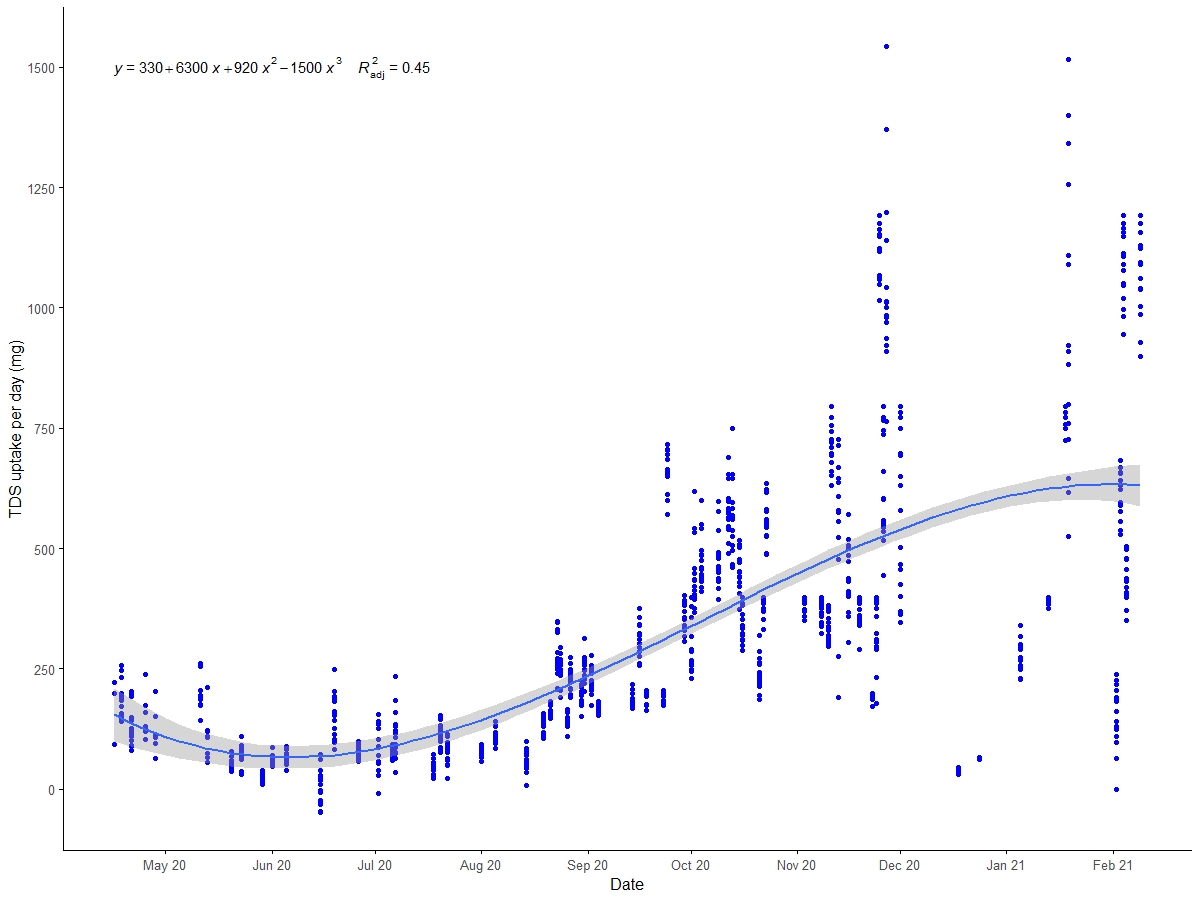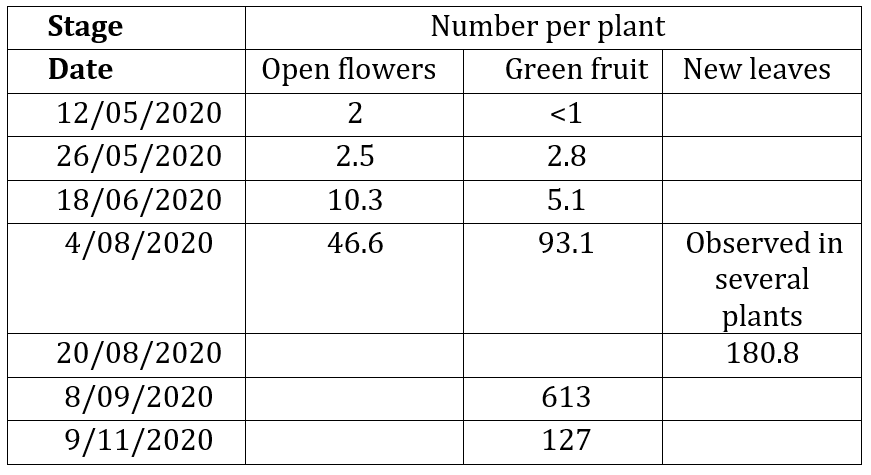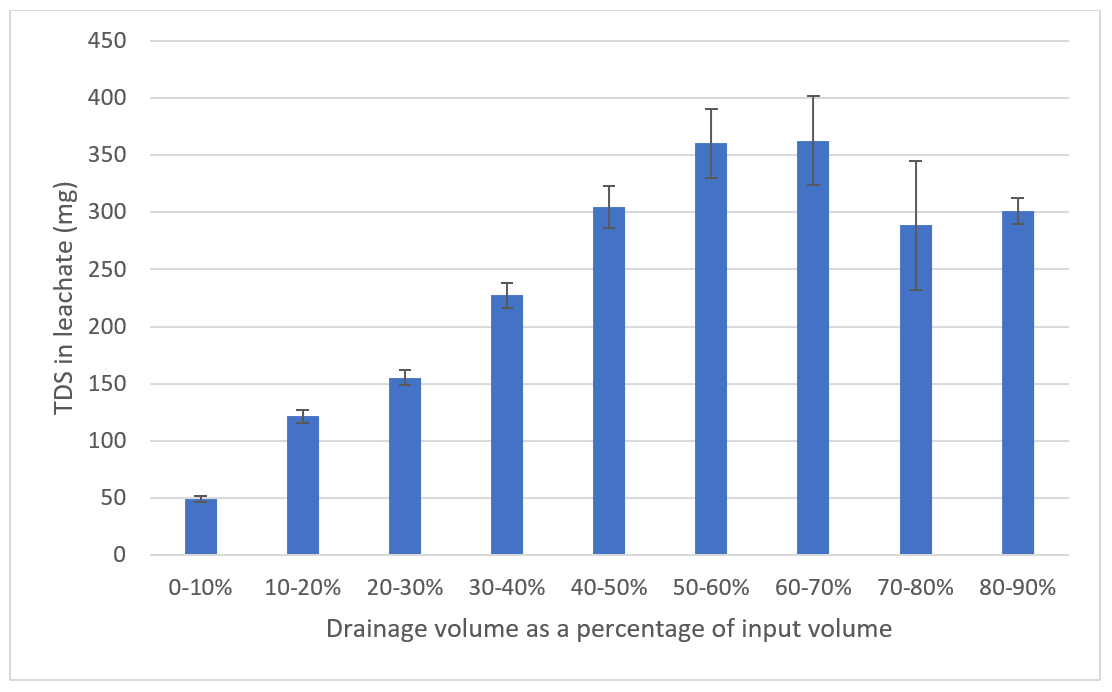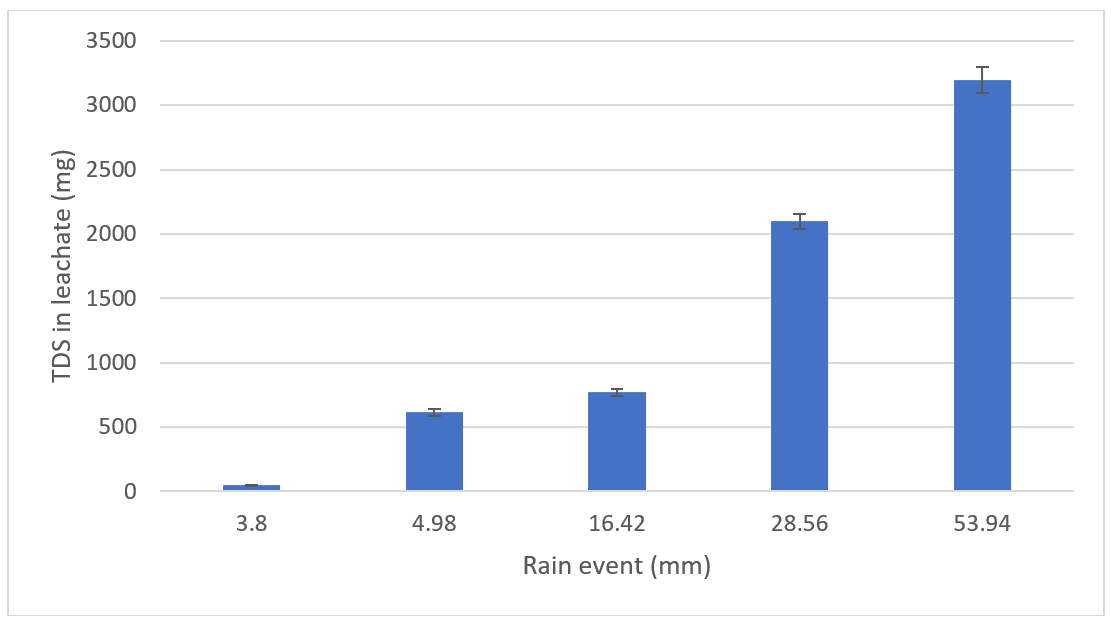
Improving the management of soilless growing media for potted Southern highbush blueberry - an Australian case study
A CCC Research Insight from Dr Sophie Parks, NSW Department of Primary Industries Senior Research Scientist, in collaboration with J Jarvis, D Unsworth, M Simpson, and D Sun.
This paper was presented by Dr Sophie Parks at the XII International Vaccinium Symposium in Canada in August 2021. It was published on the International Society for Horticultural Science (ISHS) Acta Horticulturae website in January 2023.
Key Points
- The uptake of nutrients in fertigation solution by potted blueberry plants in this study declined in late autumn through to winter, then increased in late winter associated with increased fruit production and with the development of the new canopy.
- While it is argued that nitrogen fertiliser should be ceased in late summer for northern highbush (to promote flower bud development), for southern highbush varieties that have two fruiting periods (one in winter and one in late spring), it is not clear if nitrogen fertiliser should be ceased following summer harvest.
- When plant nutrient uptake is slowest in winter (approx. 100 mg per day) drainage levels as low as 10-20% in this trial still drained more than 30% of the total salts applied. In this case, application of nutrient solution of a lower concentration would be recommended at the same drainage volume.
- Monitoring electrical conductivity (EC) and pH in blueberry pot drainage is recommended to assist in the management of crop water and nutrition, particularly to limit the risk of substrate acidification and excessive amounts of unused nutrients collected in drainage.
Abstract
The Australian blueberry industry is rapidly adopting potted substrate and fertigation for better control of crop water and nutrition. In these systems, low-chill varieties of southern highbush blueberry are grown as evergreen crops, however there is limited information available on how to use these systems more efficiently to improve production and reduce fertiliser waste.
For this Clean Coastal Catchments research, a pot trial of blueberry (Vaccinium corymbosum ‘OB1’) was established in a coir and peat substrate. The plants were fertigated with a complete nutrient solution at an electrical conductivity (EC) of 0.88 dS m-1 and pH of 5.7. The aim was to quantify the uptake of total dissolved salts (TDS) from nutrient solution by the plants and to evaluate the amount of nutrients lost in drainage.
The daily volume and EC of feed and drainage were used to calculate TDS values. The uptake of TDS by the potted plants declined in late autumn, remained low during winter fruit production, and increased in late winter, then peaked in summer with spring fruit production and the growth of the canopy.
Fertigation events producing drainage volumes of less than 40%, yielded between 49 and 227 mg of TDS, per pot, per day, and up to 400 mg of TDS for greater drainage volumes. In contrast, rain released as much as 3196 mg of TDS per pot in leachates for one 53 mm rainfall event.
This study shows how TDS estimates can be used as an index of plant demand to guide fertigation applications. The study also highlights the value in capturing nutrient-rich drainage as a resource, and to reduce the risk of leachates becoming a source of nutrient pollution off farm in the wider catchment.
Introduction
Protected cropping is widespread in the Australian blueberry industry, along with the use of soilless growing media and fertigation, to enable better control of irrigation and fertilisers. The major production area for blueberry in Australia is located on the mid-north and north coast of New South Wales, where low chill varieties of southern highbush blueberry (Vaccinium corymbosum interspecific hybrids) and rabbiteye (V. ashei) are grown as evergreen crops.
The nutrient-use efficiency of production systems in horticulture is a priority, particularly given some Australian intensive industries, including blueberry, are located near the coast and adjacent to the marine estate, creating a potential risk to water quality from diffuse nutrient pollution. In response to this risk, the Clean Coastal Catchments project was established by the NSW Government in 2018 to develop, implement and demonstrate better farm practices for the management of nutrient inputs and runoff. This approach towards agricultural industries is recognised as an important part of the wider ecosystem-based management of the marine estate (Smith et al., 2017).
The uptake of soilless systems within the blueberry industry, using potted substrate and fertigation for the delivery of water and nutrients, has been rapid. However, there is a high risk of excess nutrients being emitted from these systems, particularly as drainage is not usually captured on farm (Kaine and Giddings, 2016). Currently the fertigation practices associated with these systems are not well understood and there are no guidelines to provide growers with a model of best practice. Characterisation of the system with blueberry in potted substrate is needed before efficiency guidelines can be developed.
As part of the Clean Coastal Catchments project, a trial crop of southern highbush blueberry V. corymbosum c ‘OB1’ was established in a blend of coir and peat as the substrate and the crop was fertigated with a complete nutrient recipe. The aim of this research was to quantify the uptake of nutrients from fertigation by the combined plant and pot system and to evaluate the potential of this system to contribute to nutrient pollution. The pot drainage volumes, pH and electrical conductivity were monitored on a daily basis and this data was used to estimate the total uptake of nutrients by the system and the amount of nutrient lost in leachates.
Materials and methods
Plant production
The experiment was conducted outdoors at the NSW DPI Central Coast Primary Industries Centre, at Ourimbah, (151° 22'E, 33° 21'S), in late summer February 2020 through to February 2021. Mean monthly minimum temperatures ranged from 7.2 to 18.2 o C and mean monthly maximum temperatures ranged from 17.6 to 26.6 o C. Monthly rainfall ranged from 36.2 mm in November to 253.2 mm in October.
Sixteen four-year-old blueberry plants, V. corymbosum ‘OB1’, were potted into 52 litre plastic pots containing a substrate of coarse coir (40%), fine coir (40%) and peatmoss (20%). The substrate was buffered using gypsum prior to planting. Four 200 Litre tanks, each containing a pump, delivered a complete nutrient solution to four pots through drippers approximately twice per day with the volume applied depending on weather conditions.
In the absence of a standard nutrient solution for substrate blueberry, the nutrition in the fertigation was based on the universal nutrient solution of Steiner (1984), and both ammonium and nitrate were included as nitrogen sources. Elemental concentrations in mg L-1 were: N 39, P 12, K 79, Ca 53, Mg 23, S 56, Fe 0.8, B 0.06, Cu 0.03, Zn 0.2, Mn 0.3 and Mo 0.05. The electrical conductivity (EC) of the nutrient feed was 0.88 dS m-1 and the pH 5.7. All pots were placed on a frame to permit placement of a plastic container below each pot plant to capture all the leachate drained from the pot following fertigation and rain.
Data collection
Following fertigation or rain, the drainage from pots was collected approximately daily, except on weekends. The drainage was measured for volume, pH and EC. The total dissolved salts (TDS) of the feed and drainage solutions were estimated with the equation used for fresh water: TDS mg L-1 = 640 x EC dS m-1.
The uptake of TDS by the pot and plant system was estimated with the equation: Uptake TDS = Feed TDS – Drainage TDS. The accumulated salts within the potting substrate were not estimated separately. Phenological information, including open flower number, green fruit number and leaf number, was recorded on several occasions during the experiment.
Data analysis
A graph was plotted showing TDS uptake by pots over time using R and a polynomial line fitted to these data with a 95% confidence interval. Excel was used to calculate the means and standard errors, and to present plots, for TDS in leachate following five rain events, and following 921 fertigation events sorted into 9 drainage fractions. Data on phenological stages was averaged for presentation in a table.
Figure 1. Uptake of total dissolved salts by planted pots from fertigation, per day, during the experiment. Raw values for individual pots are presented (n = 1), with a fitted polynomial and 95% confidence interval. The low values from December were affected by heavy rain.

Results and discussion
There was a decline in the uptake of salts (TDS) from the fertigation solution by the potted blueberry plants from late autumn through to winter, before uptake started to increase in late winter (Figure 1). We observed that the late winter increase in uptake was associated with increased fruit production and the development of the new canopy by mid-August (Table 1).
This phenological pattern of TDS uptake is similar to the plant demand for nitrogen in blueberry as described in other studies. It has been shown using 15N-enriched ammonium sulfate that the rate of nitrogen uptake is driven by growth, with the greatest uptake occurring when the growth of shoots is most active (Throop and Hanson,1997).
TDS uptake peaks following harvest, coinciding with summer (from December), therefore this is a suitable period for nitrogen fertilisation to support active vegetative growth and bud development while minimising the risk of fertiliser losses (Pescie et al., 2018). Further, it is argued that nitrogen fertiliser should be ceased in late summer for northern highbush to promote flower bud development (Bryla and Strik, 2015), but it is not clear if this practice is suitable for early southern highbush varieties that have two fruiting periods, one in winter and one in late spring.
Table 1. Phenological stages observed for the crop. Values are means.
In a substrate system it is not unexpected that the risk of nutrient pollution (from uncaptured leachates following fertigation) will increase when higher drainage volumes are produced, but only a few studies have quantified this risk.
One 2011 study highlighted how up to 80% of the input fertigation was drained from a substrate cucumber crop during the first four weeks after it was planted. It was estimated that for the entire crop, an average of 59% of the applied nitrogen was lost to drainage (Grewal et al., 2011).
For the current Clean Coastal Catchments Research study, we have shown that fertigation events producing drainage volumes of less than 40%, yielded between 49 and 227 mg of TDS per pot per day (Figure 2). Volumes above this fraction should be avoided, however in this study these volumes generally occurred on weekends when fertigation could not be adjusted to suit the conditions.
The proportion of individual elements in these drained salts is yet to be estimated. Nonetheless, at its slowest TDS uptake in winter of around 100 mg per day, a drainage fraction from this crop of only 10-20% drained more than 30% of the total salts applied. In this case, application of nutrient solution of a lower concentration would be recommended at the same drainage volume.
Figure 2. Total dissolved salts in leachate discharged from pots following fertigation, grouped by drainage fraction from least to greatest (n = 156, 174, 170, 162, 105, 77, 40, 18 and 19 respectively). Values are means and bars are standard error.
Applying nutrient solution to target the demand of the blueberry crop is the recommended approach to minimise the accumulation of salts in the growing medium and the concentration of salts in drainage.
Understanding the changing demands for nutrients by blueberry as affected by season and phenology is the first step, but meeting these demands in the context of the substrate system requires careful consideration.
Blueberry plants in the current experiment appeared to perform well with a nutrient solution concentration of 0.88 dS m-1, meeting the guideline of ‘no more than 1.0 dS m-1’ and within a range of 0.5-1.0 dS m-1 as determined by Frias-Ortega et al. (2020) for V. corymbosum ‘Biloxi’.
However, for our experiment and that of Frias-Ortega et al. (2020), fertigation was constrained by not being able to modify the EC of the tanks supplying the crop until the tanks needed to be refilled.
Consequently, there were only limited options available for fertigation management including applying fertigation for a longer or shorter period, or more or less frequently, when the climatic conditions and/or plant demand changed, and clearly this limited approach lends itself to inefficient nutrient use. In-line dosing of the nutrient concentration is recommended to ensure that nutrient concentrations can be modified to suit immediate needs.
A substrate system has a high risk of nutrient pollution being released in drainage if the system is uncovered and exposed to rain events without drainage capture. Compared with the salts released in leachate from fertigation (49-363 mg per pot, Figure 2), the range of salt concentrations in leachates following rain can be similar for low to moderate rain events (48 mg per pot, Figure 3) or many times higher as in the case of the heaviest downpour (3196 mg per pot, Figure 3).
Although in Australia some blueberry crops in substrate are covered, which prevents rain on the plants, others are covered only by netting to prevent birdlife entering the crop. Covers aside, a grower may alternate fertigation with irrigation. This research shows it is possible that the associated drainage following irrigation (without fertigation) may contain salts.
Figure 3. Total dissolved salts in leachate discharged from pots following five rain events (n = 16). Values are means and bars are standard error.
Blueberry tends to favour ammonium as a nitrogen source, which in the context of a soilless substrate can exacerbate acidification of the growing medium. If this is not managed, low pH conditions in substrate limit plant growth due to root damage and nutrient deficiencies (Gorbe and Calatayud, 2010). This can lead to poor nutrient-use efficiency in the growing system.
The preference of blueberry for ammonium-N compared with nitrate-N has been demonstrated in several studies including in substrate systems (Merhaut and Darnell, 1995; Gonzales et al., 2018; Tamir et al., 2021) The associated acidification of the soil or growing medium with ammonium nutrition of blueberry has also been described, driven by ammonium uptake (Imler et al., 2019).
The properties of soilless substrates used for blueberry production can contribute to rootzone pH, for example in one study the pH of drainage from peat at planting was lower than that for coir (Kingston et al., 2017). To address this, monitoring leachate pH, and amending blueberry substrates with calcium carbonate, can assist in mitigating the acidification of substrates to undesirably low levels, without causing high pH stress (Schreiber and Nunez, 2021).
The use of potted substrate for blueberry production in Australia is a viable alternative to soil production. It is possible to use plant demand (as indicated by drainage volume and solution strength) as a guide to fertigation applications, so that the water and nutrient needs of the crop are met. Capturing the drainage from these systems will permit the reuse of this resource and limit the potential for leachates to contribute to diffuse pollution in the broader environment.
Acknowledgments
This study was financially supported by the NSW Government through the Clean Coastal Catchments program under the Marine Estate Management Strategy.
This paper was originally published on the International Society for Horticultural Science (Acta Hortulturae) website in January 2023.
Literature cited
Bryla DR, Strik BC (2015). Nutrient requirements, leaf tissue standards, and new options for fertigation of northern highbush blueberry. HortTechnology 25 (4), 464-470.
Frias-Ortega CE, Alejo-Santiago G, Bugarin-Montoya R, Aburto-Gonzalex CA, Juarez-Rosete CR, Urbina-Sanchez E and Sanchez-Hernandez E. (2020). Nutrient solution concentration and its relationship with blueberry production and quality. Cienc. Tecnol. Agropecuaria 21 (3), e1296
Gonzales LK, Rugeles LN and Magnitskiy S. (2018). Effect of different sources of nitrogen on the vegetative growth of Andean blueberry (Vaccinium meridionale Swartz). Agron. Colomb. 36 (1), 58-67.
Gorbe E and Calatayud A (2010). Optimisation of nutrition in soilless systems: A review. Adv. in Bot. Res. 53: 193-245.
Grewal HS, Maheshwari B and Parks SE (2011). Water and nutrient use efficiency of a low-cost hydroponic greenhouse for a cucumber crop: An Australian case study. Agric. Water Mgmt. 98, 841-846.
Imler CS, Arzola CI and Nunex GH (2019). Ammonium uptake is the main driver of rhizosphere pH in Southern Highbush Blueberry. Hortscience 54 (5), 955-959.
Kaine G and Giddings J (2016). Erosion control, irrigation and fertiliser management and blueberry production: grower interviews. Coffs Harbour Landcare, Hauturu.
Kingston PH, Scagel CF, Bryla DR and Strik B (2017). Suitability of sphagnum moss, coir and Douglas fir bark as soilless substrates for container production of highbush blueberry. Hortscience 52 (12), 1692-1699.
Merhaut DJ and Darnell RL (1995). Ammonium and nitrate accumulation in containerised southern highbush blueberry plants. HortTechnology 30 (7), 1378-1381.
Pescie MA, Borda MP, Ortiz DP, Landriscini MR and Lavado RS (2018). Absorption, distribution and accumulation of nitrogen applied at different phenological stages in southern highbush blueberry (Vaccinium corymbosium interspectific hybrid). Sci. Hort. 230, 11-17.
Schreiber MJ, Nunez GH. (2021). Calcium carbonate can be used to manage soilless substrate pH for blueberry production. Horticulturae 7 (4), 74.
Smith DC, Fulton EA, Apfel P, Cresswell ID, Gillanders BM, Haward M, Sainsbury KJ, Smith AD, Vince J, Ward TM. (2017) Implementing marine ecosystem-based management: lessons from Australia. ICES J. Marine Sci. 74 (7), 1990-2003.
Steiner, AA (1984). The universal nutrient solution. Proceedings of the International Society for Soilless Culture, 633-649.
Tamir G, Afik G, Zilkah S, Dai N and Bar-Tal A. (2021). The use of increasing proportions of N-NH4+ among the total applied inorganic N to improve acidification and the nutritional status and performance of blueberry plants in soilless culture. Sci. Hort. 276, 109754
Throop PA and Hanson EJ. (1997). Effect of application date on absorption of 15Nitrogen by highbush blueberry. Journal of the Am. Soc. Hort. Sci. 122 (3),422-426.




